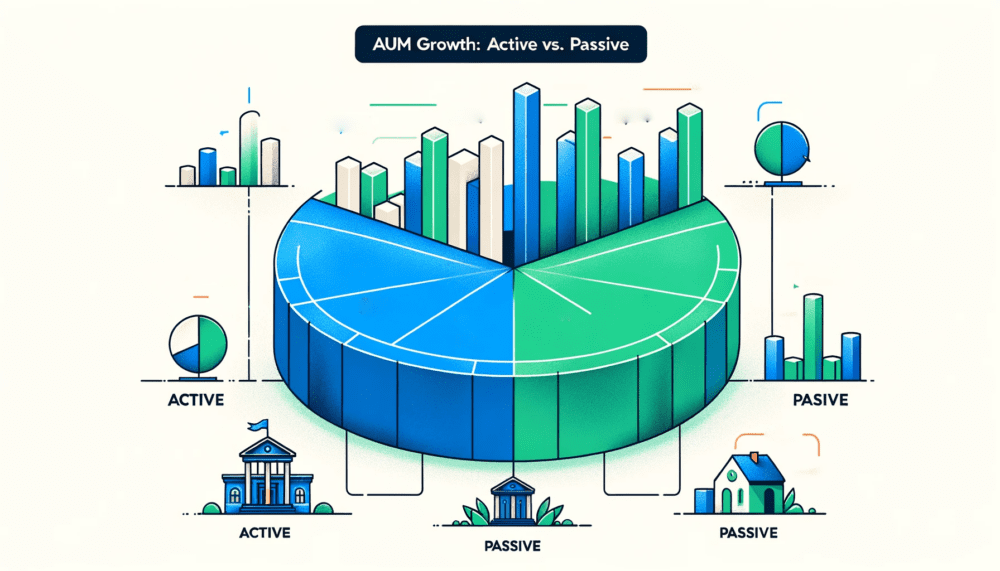Are you considering investing in mutual funds but unsure of whether to choose an active or passive approach? Both types offer unique benefits and drawbacks, and ultimately, the best choice depends on your individual financial goals and preferences. In this article, we’ll break down the differences between active and passive mutual funds so you can make an informed decision.
Understanding Active and Passive Mutual Funds
Before diving into the specifics of each strategy, it’s important to understand how they differ in their investment approach. Active mutual funds are managed by a professional fund manager who analyzes various market factors and actively selects investments to try to outperform a market benchmark, such as the Nifty 100. Passive mutual funds, on the other hand, aim to replicate the performance of a specific market index by investing in all the securities included in that index. This means that passive funds generally have lower management fees as they don’t require the same level of expertise as active funds.
What are Active Mutual Funds?
Active mutual funds aim to achieve higher returns than a market index by carefully selecting investments and taking advantage of market trends. They are managed by skilled portfolio managers who use their expertise and financial analysis to attempt to beat the market. The fund manager analyzes various market factors such as economic trends, company performance, and global events to select individual stocks and bonds. Because the fund manager’s goal is to outperform the market, active funds generally have higher management fees to pay for the costs of research and analysis.
Active mutual funds can be a good choice for investors who are willing to take on more risk in the hopes of achieving higher returns. The active management approach may also be beneficial during times of market volatility or economic uncertainty, as the portfolio manager can make adjustments to the fund’s holdings in response to changing market conditions.
What are Passive Mutual Funds?
Passive mutual funds invest in all the securities included in a specific market index, such as the Nifty 50 or S&P BSE Sensex . This means that the fund’s performance is designed to match the performance of the chosen index, rather than trying to outperform it. Passive funds generally have lower management fees than active funds because there is no need for extensive research and analysis by a portfolio manager.
Passive mutual funds can be a good choice for investors who are looking for a low-cost, low-risk investment option. Because these funds are designed to track specific market indexes, they offer a level of diversification that can help to minimize risk. Passive funds may also be a good choice for investors who are new to investing or who prefer a more hands-off approach to managing their investments.
Active vs Passive Mutual Funds: Which is Right for You?
Deciding between active and passive mutual funds ultimately comes down to your individual investment goals and risk tolerance. If you’re comfortable taking on more risk in the hopes of achieving higher returns, an active mutual fund may be the right choice for you. On the other hand, if you’re looking for a low-cost, and seeking a simple and straightforward investment option with broad market exposure, may consider index funds. These funds are particularly suitable for individuals who have a strong belief in the overall long-term growth of an index, rather than relying on any specific fund manager’s strategy. It’s important to do your research and carefully consider your options before making any investment decisions.
Comparing the Strategies
Now that we understand the differences between active and passive mutual funds, let’s take a closer look at how these strategies compare in terms of investment approach, management style, and costs and fees.
Investment Approach
Active funds aim to outperform the market, so the fund manager invests in specific securities they believe will produce the highest returns. This may involve more risk and volatility than passive investing because the manager is actively pursuing higher returns. Passive funds, on the other hand, attempt to replicate the performance of a specific market index, so they invest in all or a representative sample of the securities included in that index. This results in less risk and volatility compared to active funds because they are not trying to beat the market.
When it comes to investment approach, it’s important to consider your personal investment goals and risk tolerance. If you’re comfortable with taking on more risk in pursuit of potentially higher returns, an active fund may be a good choice for you. However, if you prefer returns which are inline with the market having no risk and volatility of active fund management, a passive fund may be a better fit.
Management Style
As previously mentioned, active fund management involves more research and analysis by the portfolio manager to try to beat the market. This means that active funds generally have higher management fees than passive funds, which only require minimal portfolio management to replicate the chosen market index.
When choosing between active and passive funds, it’s important to consider the management style and associated fees. If you’re willing to pay higher fees for the potential of higher returns, an active fund may be a good choice. However, if you prefer to keep fees low and don’t mind returns which are in line with the market, a passive fund may be a better option.
Costs and Fees
Active mutual funds generally have higher costs and fees than passive funds because they require more expertise and research by the portfolio manager. Active funds charges include management fees, operating expenses, distribution cost etc. hence they have higher expense ratios than passive funds. Passive funds however, tend to have lower fees because they require minimal portfolio management and require less in-depth research and analysis. On an average active funds charge fees between 1% to 2% per annum, whereas passive funds charge 0.05% to 0.20% which are adjusted in NAV on a daily basis. These charges vary from scheme to scheme .
It’s important to consider costs and fees when choosing between active and passive funds. While active funds may offer the potential for higher returns than benchmark, the associated fees can eat into those returns. On the other hand, passive funds may offer lower fees and returns inline with the market returns. Make sure to weigh the potential returns against the associated fees to determine which type of fund is right for you.
Performance and Returns
When it comes to performance and returns, both active and passive funds have the potential to generate positive returns for investors. However, the approach to achieving those returns differs greatly between the two strategies.


Active funds are managed by portfolio managers who aim to outperform the market by selecting individual stocks and timing their trades. They use various strategies to identify undervalued companies or those with strong growth potential. On the other hand, passive funds aim to match the performance of a specific market index, such as the Nifty 50 or S&P BSE Sensex . They do this by investing in all or a representative sample of the securities included in the index.
Historical Performance Comparison
While historical performance doesn’t guarantee future returns, it can provide insight into a fund’s past success. According to S&P Dow Jones India report the average active mutual fund underperforms its benchmark index over the long term. In contrast, passively managed index funds generally perform in line with their chosen index. This underperformance is seen majorly in large-cap based funds. This means that while active fund managers may be skilled at picking stocks, it’s challenging to consistently outperform the market.
However, it’s worth noting that there are exceptions to this rule. Some active fund managers have been able to consistently beat the market over the long term.
Risk and Volatility
Because actively managed funds have a more hands-on approach to managing investments, they may have higher risk and volatility than passive funds. The portfolio manager has the flexibility to make significant changes to the fund’s holdings, which can result in higher returns but also higher risk. Passive funds, which invest in all or a large representative sample of the securities included in the index, tend to have less risk and volatility because they are not trying to outperform the market.
However, it’s important to note that not all passive funds are created equal. Some passive funds may have higher risk and volatility if they track a more volatile index, such as a small-cap index or mid-cap index. It’s important for investors to understand the specific risks associated with a particular index before investing in a passive fund.
In conclusion, both active and passive funds have their pros and cons when it comes to performance and risk. Investors have the option to choose passive funds when investing in large-cap-based funds. Passive funds track established indexes, making them suitable for investors seeking exposure to the broader market without relying on a fund manager’s expertise. On the other hand, active funds may be preferred when investing in mid or small-cap stocks. The expertise of a fund manager becomes crucial in evaluating and selecting stocks within these segments, as they offer potential growth opportunities beyond the large-cap space. So one should carefully consider their investment goals and risk tolerance before deciding which strategy to pursue.
Conclusion
The cost of active management often hinders many active managers from outperforming the index once expenses are considered. Consequently, passive investing has emerged as a preferred choice due to its lower fees. However, the decision between active and passive investing also hinges on the level of risk one is willing to assume. While some active funds have outperformed the benchmark, they typically entail higher risks. Ultimately, the choice depends on your risk profile and investment style.It is crucial to conduct thorough research and consult with a qualified financial advisor before making any significant investment decisions.










